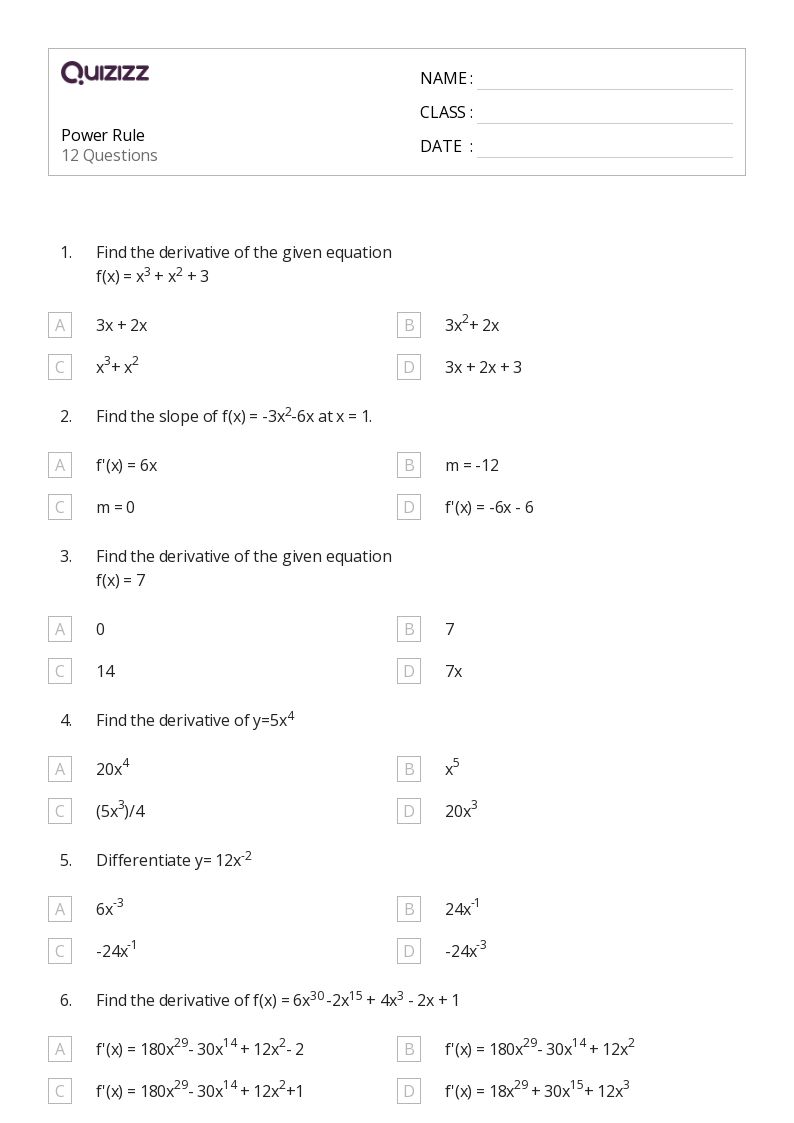Chain Rule Derivative Worksheet
Chain Rule Derivative Worksheet - F ( x) = sin 2 x3. In this unit we learn how to differentiate a ‘function of a function’. Using the chain rule is a common in calculus problems. (a) consider f(x) = x and g(x) = (x + 1)2; The method of differentiating composite functions. Free trial available at kutasoftware.com.
Free trial available at kutasoftware.com. Check that both answers give the same. (a) consider f(x) = x and g(x) = (x + 1)2; Cos 2 + x 5 period: Dx + 5 ) ( 3 x ) 3.
Do your work on a separate page. Here is a set of practice problems to accompany the chain rule section of the derivatives chapter of the notes for paul dawkins calculus i course at lamar university. Differentiate each function with respect to x. State the chain rule for the composition of two functions. For each problem, you are given a.
In this unit we learn how to differentiate a ‘function of a function’. Chain rule of derivative : Use the given table to answer the following questions. State the chain rule for the composition of two functions. Rewrite the function x x2+1 = x(x2 + 1) 1 and use the product and chain rule.
Check that both answers give the same. Combine the differentiation rules to find the derivative of a polynomial or rational function. Do your work on a separate page. The chain rule g(x))g0(x) is called the chain rule. Dx + 5 ) ( 3 x ) 3.
(a) consider f(x) = x and g(x) = (x + 1)2; The method of differentiating composite functions. Rewrite the function x x2+1 = x(x2 + 1) 1 and use the product and chain rule. For each problem, you are given a table containing some values of differentiable functions f (x) , g(x) and their derivatives. Dx ( sin 2( x.
The chain rule g(x))g0(x) is called the chain rule. Rewrite the function x x2+1 = x(x2 + 1) 1 and use the product and chain rule. Write the chain rule in both leibniz and newtonian notation. Here is a set of practice problems to accompany the chain rule section of the derivatives chapter of the notes for paul dawkins calculus.
Chain Rule Derivative Worksheet - Using the chain rule is a common in calculus problems. Here is a set of practice problems to accompany the chain rule section of the derivatives chapter of the notes for paul dawkins calculus i course at lamar university. The student will be given composite functions and will be asked to differentiate them. Create your own worksheets like this one with infinite calculus. In this unit we learn how to differentiate a ‘function of a function’. Compute the derivative of in two ways:
We first explain what is meant by this term and then learn about the chain rule which is the technique used to perform the. Differentiate each function with respect to x. Combine the differentiation rules to find the derivative of a polynomial or rational function. Then, f0(x) = f0(g(x))g0(x) 5. Cos 2 + x 5 period:
13) Give A Function That Requires Three Applications Of The Chain Rule To Differentiate.
Create your own worksheets like this one with infinite calculus. The chain rule says (f(g(x)))0 = f0(g(x))g0(x), or (f(u))0 = f0(u)u0(x) if u = g(x). Free trial available at kutasoftware.com. Find the period and the derivative for the following sinusoidal functions.
Using The Chain Rule Is A Common In Calculus Problems.
In this unit we learn how to differentiate a ‘function of a function’. Here is a set of practice problems to accompany the chain rule section of the derivatives chapter of the notes for paul dawkins calculus i course at lamar university. Write the chain rule in both leibniz and newtonian notation. Now, y is a function of u and u is a.
The Chain Rule This Worksheet Has Questions Using The Chain Rule:
Check that both answers give the same. The student will be given composite functions and will be asked to differentiate them. Dx ( √ 2x 2 2. State the chain rule for the composition of two functions.
Then, F0(X) = F0(G(X))G0(X) 5.
Chain rule of derivative : Chain rule ( cos ( 2x ) ) 1. On the right side, substitute y = u3 and u = x2 + 5 and find the derivatives. Combine the differentiation rules to find the derivative of a polynomial or rational function.




